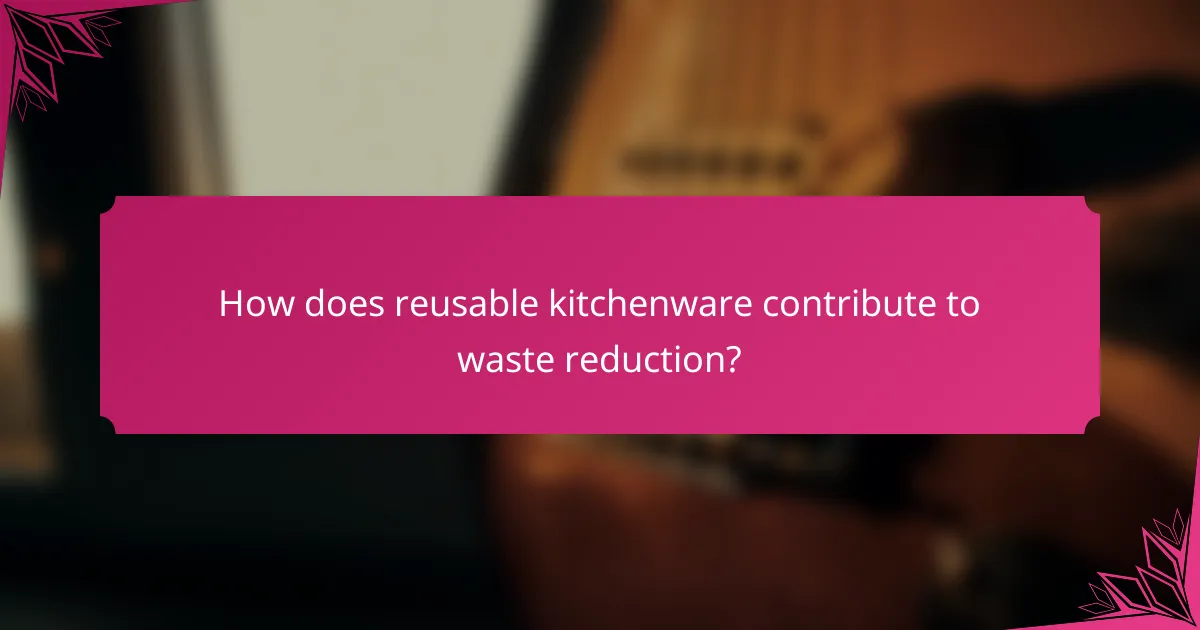Reusable kitchenware is a game-changer for meal prep, enhancing efficiency and making cooking more enjoyable. By reducing reliance on single-use items, these tools not only promote sustainability but also improve health by minimizing exposure to harmful chemicals. Embracing reusable options helps streamline cooking processes while contributing to a healthier planet.

How can reusable kitchenware improve meal prep efficiency?
Reusable kitchenware enhances meal prep efficiency by streamlining processes, reducing time spent on cooking and cleaning. With thoughtful designs, these tools help organize ingredients and simplify cooking tasks, making meal preparation quicker and more enjoyable.
Time-saving designs
Time-saving designs in reusable kitchenware often feature user-friendly elements such as easy-pour spouts, measurement markings, and ergonomic handles. These innovations minimize the time spent on tasks like pouring, measuring, and mixing, allowing cooks to focus on the actual meal preparation.
For instance, a set of measuring cups that stack neatly can save space and time during the cooking process. Look for tools that offer quick-release mechanisms or one-handed operation to further enhance efficiency.
Stackable storage options
Stackable storage options are essential for maximizing kitchen space and keeping ingredients organized. Containers that can be neatly stacked reduce clutter and make it easier to access items quickly, which is crucial during meal prep.
Consider using clear, stackable containers that allow you to see contents at a glance. This not only saves time but also helps in planning meals effectively, as you can quickly assess what ingredients are available.
Multi-functional tools
Multi-functional tools combine several kitchen tasks into one, significantly improving efficiency. For example, a blender that also functions as a food processor can eliminate the need for multiple appliances, saving both time and counter space.
When selecting multi-functional kitchenware, look for tools that can handle various cooking methods, such as steaming, sautéing, and blending. This versatility allows for quicker transitions between meal prep stages and reduces the overall cleanup effort.

What are the health benefits of using reusable kitchenware?
Using reusable kitchenware can significantly enhance your health by minimizing exposure to harmful chemicals and improving food safety. These benefits stem from the materials used and the way reusable items help preserve food quality.
Reduced chemical exposure
Reusable kitchenware, especially those made from glass, stainless steel, or silicone, typically contain fewer harmful chemicals compared to single-use plastic options. Many plastics release toxins, particularly when heated, which can leach into food and beverages.
Choosing high-quality, BPA-free materials can further reduce the risk of chemical exposure. Look for products that comply with safety standards, such as FDA regulations in the United States or similar guidelines in other countries.
Better food preservation
Reusable kitchenware often provides superior food preservation compared to disposable alternatives. Containers with airtight seals can keep food fresh longer, reducing spoilage and waste. This is particularly beneficial for meal prep, allowing you to store prepared meals safely for several days.
For optimal food preservation, consider using glass containers with silicone lids or vacuum-sealed bags. These options not only maintain food quality but also help you save money by reducing the need for frequent grocery shopping.

How does reusable kitchenware contribute to waste reduction?
Reusable kitchenware significantly reduces waste by minimizing the reliance on single-use items, which often end up in landfills. By opting for durable alternatives, consumers can decrease their environmental footprint and promote sustainable practices in their daily lives.
Minimized single-use plastics
Using reusable kitchenware directly reduces the demand for single-use plastics, such as disposable plates, cutlery, and containers. These items contribute to a substantial amount of plastic waste, which can take hundreds of years to decompose. By switching to reusable options, individuals can help mitigate this environmental issue.
For example, replacing plastic wrap with reusable silicone covers or opting for glass containers instead of plastic ones can significantly cut down on plastic consumption. Many households can reduce their single-use plastic waste by over 50% simply by making these changes.
Long-lasting materials
Reusable kitchenware is typically made from durable materials like stainless steel, glass, or high-quality silicone, which can last for years with proper care. This longevity not only reduces waste but also saves money in the long run, as consumers spend less on replacements.
When selecting reusable items, look for those that are dishwasher-safe and resistant to wear and tear. Investing in high-quality products can lead to a more sustainable kitchen setup, ultimately contributing to a healthier planet.

Which brands offer the best reusable kitchenware?
Several brands stand out for their high-quality reusable kitchenware, focusing on durability, functionality, and sustainability. Pyrex, Stasher, and Bee’s Wrap are among the top choices, each offering unique products that cater to different meal prep needs.
Pyrex for glass storage
Pyrex is renowned for its glass storage containers that are perfect for meal prep and leftovers. These containers are made from durable borosilicate glass, which can withstand high temperatures and is microwave, oven, and dishwasher safe.
When using Pyrex, consider the sizes available, which typically range from small 0.5-liter containers to larger 3-liter options. This variety allows for efficient storage of different meal portions, making it easy to organize your fridge or freezer.
Stasher for silicone bags
Stasher offers a line of reusable silicone bags that are versatile and eco-friendly. These bags are perfect for storing snacks, marinating proteins, or even sous-vide cooking, as they can withstand temperatures from -40°F to 400°F.
Stasher bags come in various sizes, including snack, sandwich, and quart sizes, allowing for flexible meal prep. They are easy to clean and can be tossed in the dishwasher, making them a practical alternative to single-use plastic bags.
Bee’s Wrap for food wraps
Bee’s Wrap is a sustainable alternative to plastic wrap, made from organic cotton infused with beeswax, jojoba oil, and tree resin. These wraps are reusable and can be molded around food items or containers using the warmth of your hands.
Available in various sizes, Bee’s Wrap is ideal for wrapping sandwiches, covering bowls, or storing fruits and vegetables. To maintain their longevity, wash them in cold water with mild soap and avoid using them with raw meat or in high heat situations.

What factors should you consider when selecting reusable kitchenware?
When selecting reusable kitchenware, consider material safety, size and capacity, and ease of cleaning. These factors directly impact your health, convenience, and the effectiveness of your meal prep.
Material safety
Material safety is crucial when choosing reusable kitchenware, as it affects both health and food quality. Look for products made from food-grade materials such as stainless steel, glass, or BPA-free plastics. Avoid items that may leach harmful chemicals, especially when heated.
Check for certifications like FDA approval or compliance with relevant safety standards in your country. This ensures that the materials used are safe for food contact and do not pose health risks.
Size and capacity
Size and capacity are essential considerations for effective meal prep. Choose containers that fit your portion sizes and storage needs, whether for individual meals or family servings. Common sizes range from 250 ml for snacks to several liters for bulk storage.
Consider stackable designs to save space in your kitchen. Additionally, ensure that the containers fit well in your refrigerator or pantry to maximize storage efficiency.
Ease of cleaning
Ease of cleaning can significantly influence your experience with reusable kitchenware. Opt for materials that are dishwasher-safe or easy to hand wash, as this will save you time and effort. Non-stick surfaces can also simplify cleaning but ensure they are free from harmful coatings.
Look for containers with wide openings for easy access and cleaning. Avoid intricate designs that may trap food particles, making them harder to clean thoroughly.

How can you effectively organize reusable kitchenware?
To effectively organize reusable kitchenware, focus on categorizing items by type and frequency of use. This approach enhances accessibility and efficiency during meal prep, ultimately saving time and reducing clutter.
Drawer dividers
Drawer dividers are essential for keeping reusable kitchenware organized and easily accessible. They help separate utensils, containers, and lids, preventing chaos in your drawers. Consider adjustable dividers that can be customized to fit various drawer sizes and contents.
When using drawer dividers, ensure they are sturdy and easy to clean. Look for materials like bamboo or plastic that can withstand daily use and spills. A well-organized drawer can significantly speed up meal prep by allowing you to find what you need quickly.
To maximize efficiency, categorize items within the dividers. For example, place all measuring cups in one section and all food storage containers in another. This method not only saves time but also helps maintain a tidy kitchen environment.
